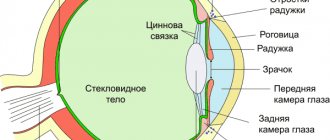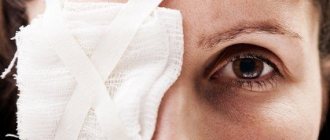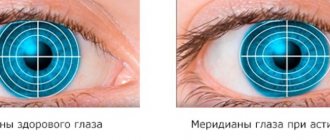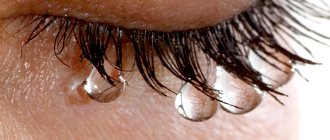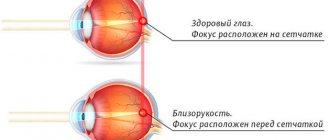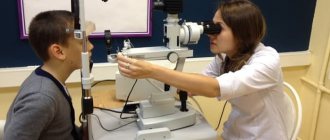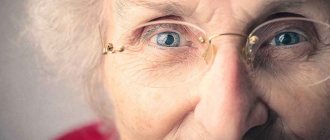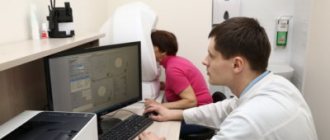Due to the widespread introduction of modern technologies, people increasingly complain that their eyes get tired. This symptom can occur in a person of any age, most often it is associated with visual strain. The condition requires mandatory consultation with an ophthalmologist and treatment.
Why does asthenopia appear?
Most often, asthenopia occurs in those who need to work on a PC for a long time, read a lot of documents, various books and papers. But these are not all the reasons. The second condition for the occurrence of asthenopia is visual impairment:
- myopia;
- farsightedness;
- astigmatism;
- age-related changes.
There is muscular and accommodative asthenopia. The latter develops due to fatigue of the ciliary muscle of the eye, which is responsible for regulating the curvature of the lens, with its strong tension, astigmatism, and farsightedness. Intoxication and general diseases also contribute to this.
Muscular asthenopia appears with congenital weakness of the rectus intrinsic muscles of the eye, but is more common with uncorrected myopia. It may be accompanied by disturbances in binocular vision, as well as strabismus.
Often complaints of eye fatigue are caused by manifestations of dry eye syndrome, since with prolonged concentration the number of blinks decreases, and hence the secretion of tear secretion.
Reference. An important role in the formation of eye fatigue is played by the low level of psychological adaptation to visual stress.
Air hygiene
The air around your computer has low humidity, and heating units and air conditioners can dry it out even more. During intense visual stress, the frequency of blinking movements reflexively decreases. In dry air, the tear film quickly evaporates, causing dryness and redness of the eyes. To keep your eyes sufficiently hydrated, maintain optimal humidity in the room using humidifiers, ventilation and frequent wet cleaning, drink more fluids and try to blink more often.
Symptoms
Asthenopia manifests itself with ocular and visual symptoms:
- a veil before the eyes;
- blurring and doubling of objects;
- the shape and size of images are distorted;
- eyes become inflamed;
- the production of tear secretion increases;
- there is a feeling of fatigue in the eyes, a feeling of increasing their temperature;
- discomfort, pain, pain and burning appear.
In this case, headaches and increased irritability often occur. Blepharitis or conjunctivitis often develops against this background.
There are several stages in the clinical course of asthenopia:
- Compensation.
- Subcompensations.
- Decompensation.
At the first stage, the patient experiences a short-term disturbance in visual function, which remains within normal limits. Because of this, a compensated form of eye fatigue is visual discomfort, which appears after strain on the eyes and a short rest. At this stage, a person may experience a burning sensation, increased production of tear secretion, redness, and blurred vision.
The second stage involves long-term visual impairment that is potentially reversible. At this stage, there may be a feeling of sand and pain in the eyes. The image may appear double or distorted. It is important to note that functional vision disorders can manifest themselves 1-2 days after rest, and appear even after a slight load.
Therapeutic gymnastics according to the method of the famous ophthalmologist W. Bates:
- — Standing by the window, look at a very distant object for 10 seconds, then turn your gaze to your wristwatch. The exercise must be repeated 15 times.
- — Standing in the corner of the room, without turning your head, quickly move your gaze from the upper right corner of the room to the lower left, from the upper left to the lower right. Repeat 50 times.
- — Standing in front of a bright light source, look at the bright light for 3 seconds, then close your eyes with your hand and let them rest. Repeat the exercise 15 times.
It is recommended to perform such exercises twice a day. A month after starting training, you need to take a break for 2-3 weeks, and then start all over again.
Eye topics pharmacy eye exercises
How to relieve tension?
Nature has thought out everything, including the structure of the eye, which provides natural protection. But due to unfavorable external conditions of the human environment, this protection decreases. What to do? How to relieve eye tension? There are such simple methods:
- Blinking more frequently. You need to remind yourself of this during hard work, because... In moments of concentration, we forget about this, which causes dry corneas and eye fatigue.
- Moisturizing eye drops. Pharmacies offer special preparations that mimic the composition of tears. If it was not possible to avoid fatigue naturally, then you can use the help of pharmaceuticals.
Useful video
Symptoms of asthenopia. How to relieve eye strain:
Exercises
There are special exercises to relieve eye fatigue:
- Close your eyes forcefully 5-8 times. You need to close your eyes, squeezing your eyelids for a few seconds. After that, open them and sit quietly for 30 seconds.
- Close your eyes and place the backs of your hands on them. After this, remove your hands and open your eyes. Repeat 10 times.
- Take a pencil and hold it out in front of you. You need to concentrate your gaze on the tip. After this, move your hand to the right, left horizontally, but the movements should be slow. You need to follow the tip of the pencil with your eyes, but do not use your neck muscles, i.e. don't move your head. Only the eye muscles should work.
- Another effective exercise is the Figure Eight. Take a comfortable position, relax your shoulders and neck. Draw a figure eight with a large amplitude in the air with your eyes. You need to roll your eyes slowly. Repeat 10 times, then close your eyes for 10 minutes.
Masks
The most common and fastest recipes for masks to relieve fatigue:
- Ice cubes. You need to apply ice to your closed eyes, but be careful not to overcool your vision.
- Fresh cucumbers. Place cucumber slices on closed eyelids and leave for 10-15 minutes.
- Raw potatoes. Grate clean potatoes and place on cheesecloth. Cover your eyelids for 15-20 minutes.
Compresses
Popular compress recipes:
- Tea bags. You need to take used tea bags, warm or cold. Apply them to your eyes and lie there for 10-15 minutes in the morning or evening. Do not use tea with additives. Regular black will do.
- Chamomile. Perfectly fights eye fatigue and helps prevent various diseases. Pour 1 tsp. dried flowers 0.5 liters of boiling water. Let stand for 10 minutes and pour half into a jar, which is placed in the refrigerator. Alternately moisten the gauze with warm and cold broth and apply compresses to the eyes. The procedure should last 10 minutes before bedtime.
- Dill seeds. The method of preparation and use is similar to chamomile.
- Cornflower. 1 tsp. pour ½ liter of boiling water over the flowers and let stand for an hour. Soak cotton pads in the infusion and apply to eyes for 15 minutes.
Help for tired and sore eyes. Advice from ophthalmologists:
- — If a blood vessel in the eye ruptures, vitamin C will help. Buy ascorbic acid at the pharmacy or eat citrus fruits.
Problem skin: what vitamins and elements are you missing?
- — If you work a lot at the computer, include dietary supplements from dry blueberry extract and beta-carotene into your diet.
Blueberries contain up to 15 different types of substances (anthocyanosides), which improve visual acuity and strengthen the retina. Eye vitamins are offered in a wide range in pharmacies. Take, for example, a course of Blueberry Forte vitamins.
It's even better if you have blueberry jam that you or your family made yourself. Tea with blueberry jam for breakfast will greatly help your eyes.
- — The cause of eye inflammation is not so easy to establish: it can be cosmetics, cigarette smoke, improper lighting, etc.
Perhaps you are allergic to a certain brand of mascara, pencil or eye shadow, or you simply did not wash off your makeup at night; particles of cosmetics got into your eyes, causing irritation.
Remember to thoroughly cleanse your eyes of makeup before going to bed. Makeup remover is applied to a cotton pad and cosmetics are removed using massaging movements from the outer eyelid to the inner one. You cannot remove waterproof mascara either with soap or regular products. You need a waterproof makeup remover. After cleansing your eyes of makeup, apply a moisturizing or toning eye cream to the lower and upper eyelids.
Cosmetic cream, toner or soap?
Severe redness of the eyes can be caused by overwork at work, especially if you wear contact lenses. By the way, under no circumstances should you drop Visine to relieve redness if you wear contact lenses, this will increase irritation and inflammation of the eyes and provoke allergies.
In summer, when the sun is bright, wear sunglasses. Glasses lenses must be made of high-quality material and have UV protection.
Current trends in sunglasses
What to do if children's eyes get very tired?
Eye fatigue is also a common problem for children, since they often do not follow the rules for using smartphones, computers, and TV, and are forced to read a lot at school and at home.
During breaks, you need to be distracted and rest your eyes. You can do gymnastics for the muscles of the back, neck and eyes. Invite your child to stretch upward, then bend over, do a couple of squats, and stretch his neck in a circular motion. The key goal of gymnastics for children's eyes is to stretch the external muscles:
- Move your eyes in different directions.
- Make circular movements with them.
- Blink frequently.
- Look out the window at distant objects.
Monitor the duration of continuous reading, sitting at a PC or smartphone. The maximum duration of visual strain is 30-45 minutes. After this, a break is necessary. Work at the computer needs to be interrupted even more often - every 15-30 minutes.
Important! If gymnastics and adherence to the exercise regime do not help, then you should consult a doctor and not experiment with children's vision.
Herbal and vitamin/mineral products
An additional stimulator for the excellent functioning of the visual organs are preparations made on the basis of plant components. They will be especially effective for people in old age, when the eyes get tired often and for no apparent reason - a feature of age-related changes in the body. In this case, you should pay attention to:
- blueberries - both fresh berries and syrups with tablets based on them help strengthen the optic nerves and muscle tissue of the organs of vision;
- Ginkgo biloba – improves blood circulation in the brain, helps stabilize circulatory processes in the organs of vision.
It would be a good idea to take a course of medications enriched with vitamins A and E, copper and zinc, and lutein. Such remedies normalize intraocular pressure, strengthen the optic nerves, and prevent fatigue.
Ophthalmologists recommend taking medications based on herbal ingredients and enriched with vitamins and microelements.
Some ophthalmologists offer their patients to treat eye fatigue with color therapy. It is well known that green and blue colors have a calming and restorative effect on the organs of vision. If a person spends a lot of time in front of a computer monitor, then above his desktop you can place paintings/photos depicting foliage of trees, summer sky, grass. It is enough to look at such an image once an hour for 3-5 minutes and you can really feel how the functionality of the eyes is restored.
If your eyes get tired regularly, then you shouldn’t experiment with medications and special exercises. A reasonable decision would be to contact an ophthalmologist, who will examine the patient and give competent recommendations. Otherwise, you may miss the onset of the pathological process, which will lead to partial or complete loss of vision.
Prevention
To prevent eye fatigue, you should do exercises regularly. In addition, asthenopia is prevented by other methods:
- while working and reading, you need to sit straight;
- It is important to take regular breaks when using electronic devices and reading;
- do not use vision correcting products without a prescription;
- proper nutrition and vitamins;
- the workplace should be comfortable and safe for vision (moderate screen brightness, good lighting);
- frequent walks in the fresh air;
- Regular eye examinations by an ophthalmologist.
Optimal monitor settings
Optimal brightness, contrast and color settings of the monitor should be aimed at an individual level that is comfortable for the eyes. These parameters can be changed during the day depending on the lighting and the nature of the work. Modern monitors and operating systems allow you to configure all settings manually or select a ready-made mode that suits you (for example, night, bright or automatic). Designers, artists and photographers are unlikely to suit anything non-standard - in order not to distort colors too much, you can reduce the brightness in the dark and increase it in the light.
The flicker rate and resolution of the monitor should be at the highest possible level. This will ensure high image quality and reduce irritation from flickering and blurry images.
Does proper organization of the workplace help relieve computer eye fatigue?
Working at a computer every day exposes your eyes to a number of risks. They cannot be avoided, but with proper organization of work and workspace, their impact can be minimized. To do this you need:
- Rearrange the monitor. Position the screen below your line of sight. When looking down, the lacrimal glands produce more tears, so the cornea does not dry out and the eye muscles do not overwork. Place the monitor at a distance of at least 80-110 cm from your face to maintain posture and reduce eye strain.
- Reduce glare. To do this, turn the screen away from external light reflections. If necessary, use blinds to reduce the amount of light in the room. You can also stick anti-glare film on the monitor and wear special computer glasses. Special lenses installed in computer glasses improve image contrast, eliminate glare, and protect the retina from the harmful blue spectrum.
- Take breaks. Monotonous tasks lead to rapid fatigue of the visual organs. Therefore, to stabilize their condition, take a break of at least 5-7 minutes every hour. This will help avoid overwork of the eye muscles and improve blood circulation in the visual organs.
- Adjust your monitor settings. To minimize the negative impact of the computer, set the contrast to the highest possible level, increase the font size if necessary, and use the classic combination of black text and white background. Set the brightness according to the lighting level.
One common tip for relieving computer eye strain involves replacing your monitor. Modern LCD displays have a high refresh rate, anti-glare coating, and provide convenient viewing of information.

